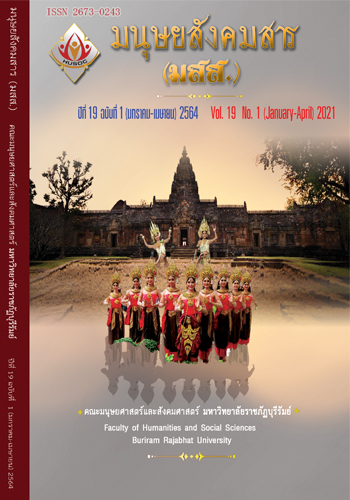Effects of Cognitive Styles and Storytelling Patterns with Digital Storytelling Activities upon Critical Thinking Skills of Undergraduate Teacher Students
Main Article Content
บทคัดย่อ
This research aimed to 1) compare different cognitive styles with digital storytelling activities that affect the critical thinking of undergraduate teachers students, 2) to compare different storytelling Pattern that affect the critical thinking of undergraduate student teacher, 3) To study the interaction between thinking styles and storytelling Pattern with digital storytelling activities that affect the critical thinking of undergraduate student teachers. The results of the research were as follows:1) Different cognitive styles with digital storytelling activities that affected the critical thinking of undergraduate teacher students are different with no significance at .05 level (F = .476, Sig = .492). 2) Different narrative styles that affect critical thinking of undergraduate student teachers were different with no significance at .05 (F = .062, Sig = .803). 3) There was an interaction between cognitive styles and storytelling Pattern with digital storytelling activities that affected the critical thinking of undergraduate student teachers (F = 8.470, Sig = .004).
Article Details

อนุญาตภายใต้เงื่อนไข Creative Commons Attribution-NonCommercial 4.0 International License.
เนื้อหาและข้อมูลในบทความที่ลงตีพิมพ์ในวารสารทดสอบระบบ ThaiJo2 ถือเป็นข้อคิดเห็นและความรับผิดชอบของผู้เขียนบทความโดยตรงซึ่งกองบรรณาธิการวารสาร ไม่จำเป็นต้องเห็นด้วย หรือร่วมรับผิดชอบใดๆ
บทความ ข้อมูล เนื้อหา รูปภาพ ฯลฯ ที่ได้รับการตีพิมพ์ในวารสารทดสอบระบบ ThaiJo2 ถือเป็นลิขสิทธิ์ของวารสารทดสอบระบบ ThaiJo2 หากบุคคลหรือหน่วยงานใดต้องการนำทั้งหมดหรือส่วนหนึ่งส่วนใดไปเผยแพร่ต่อหรือเพื่อกระทำการใดๆ จะต้องได้รับอนุญาตเป็นลายลักอักษรจากวารสารทดสอบระบบ ThaiJo2 ก่อนเท่านั้น
เอกสารอ้างอิง
Ennis, R. H. & Millman, J. (1985). Cornell critical thinking test level X and level Z-manual, 3ed ed. CA: Midwest Publication.
Kaeophanuek, S. (2017). Digital heritage development model using critical inquiry digital storytelling on web3.0 to enhance digital literacy of undergraduate information science students. Doctoral Thesis. Education Technology and Communication, Department of Educational Technology And Communication, Faculty of Education Chulalongkorn University. [in Thai]
Miller, E. A. (2009). Digital storytelling. (Master of Arts), University of Northern Iowa, USA.
Phetmark, S. (2017). Interaction of communication formats and personality in teaching problems solve in virtual reality flipped classroom upon abilities in problems solve of undergraduate students. Doctoral Thesis in Information and Communication Technology, Faculty of Education, Surindra Rajabhat University. [in Thai]
Philuek, W. (2001). Charecteristics of links upon hoosing links in educational web of elementary school students with different cognitive styles. Master's Thesis. Department of Audiovisual Studies, Faculty of Education, Chulalongkorn University. [in Thai]
Prangsorn, S. (2012). Thinking patterns and teaching and learning. Journal of Vocational and Technical Studies, (2nd Year). Issue 4 July–December. Page 4. [in Thai]
Premsriratana, U. (2015). Storytelling in communication arts: Study from research. Journal of Communication Arts and NIDA. 2ndYear. Issue No. 1 (Jan.-Jun. 2015). Page 31. [in Thai]
Robin, B. R. (2016).The Power of digital storytelling to support teaching and learning. Digital Education Review, (30). 17-29
Robin, B. R. & McNeil, S. G. (2012). What educators should know about teaching digital storytelling. Digital Education Review (22), 37-51.
Riding, R.J. & Sadler-Smith, E. (1997). Cognitive styles and learning strategies: Some applications for training design. International Journal of Training and Development, 1, pp.199-208.
Srimuang, K. (2016). A comparison of a small group discussion on Facebook Towards the critical thinking ability of undergraduate students. Surin Rajabhat University. Master's Thesis. Information and Communication Technology Education Program. Faculty of Education. Surindra Rajabhat University. [in Thai]
SukwonLee. (2017). Investigation of visualization literacy: A visualization sense making model, a visualization literacy assessment test, and the effects of cognitive characteristics. Degree of doctor of Philosophy. Purdue University West Lafayette, Indiana.
Thabthiang, B. (2003). Using the critical thinking skill set population matters with local environment of Mathayomsuksa 3 students Ban Pong Noi school mueang Chiang Mai district. Master's Thesis. Department of Social Studies Teaching, Faculty of Education. Chiang Mai University. [in Thai]
Thepprasit, W. (2002). Effects of tangible levels on folk computers game Teaching presentations on an understanding of the game play of 1st Grade students with different thinking patterns. Master of Science Program in Audiovisual Science, Department of Audiovisual Studies, Faculty of Education, Chulalongkorn University. [in Thai]
Yang, Y.-T. C. & Wu, W.-C. I. (2012). Digital storytelling for enhancing student academic achievement, critical thinking, and learning motivation: A year-long experimental study. Computers& Education, 59(2), 339-352.


